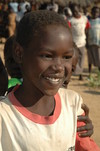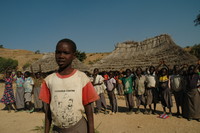The Political Context
From 1985, the Nuba Mountains of Southern Kordofan, in central Sudan, were devastated by civil war until January 19, 2002, when a ceasefire was signed between the central government and the Sudan People Liberation Movement/Army (SPLM/A).
The war affected and interrupted all the area’s basic services. Many children were traumatized and victimized, and some were separated from their parents and immediate guardians. Aerial bombardment of community centres, villages, markets and farms has left Nuba children living in constant fear.

With the signing of a Comprehensive Peace Agreement in January 2005, peace and stability were reinforced. Power and wealth are expected to trickle down from the Government of National Unity to the State, and for the first time in history, the Nuba people will enjoy self-governance.
The few schools that were established prior to the war were ruined and used for purposes other than learning. As a result, an entire generation of Nuba children lost opportunities for learning.
Starting in 1995, the SPLM/A, encouraged the establishment of community schools. At that time, up to now, the Nuba living in the SPLA controlled area have rejected Arabic-patterned education. The establishment of a new curriculum will continue throughout the interim period that is set to last up to 2011.
The Economic Context
There have been tremendous changes in the Nuba Region after the ceasefire agreement. The barter economy is gradually being replaced by a monetized system. Chains of markets have blossomed in the recent past in areas such as Kauda, Komu and Luwere, with commodities finding their way out of East Africa.

Civilians now have the opportunity to access markets without restriction because of the institution of freedom of movement. International agencies have embarked on major road rehabilitation projects, thus facilitating the transportation of goods, and micro-finance institutions are expected to operate soon through the Nuba Relief, Rehabilitation and Development Council (NRRDC).
The Socio-Cultural Context
The Nuba area’s newfound peace and stability has opened avenues for many internally displaced Nuba people (IDPs) and those exiled in the East African countries to return home.
The return of these former IDPs and exiles has had far reaching consequences on the social and cultural setup of the area. Population has increased, and the returnees have brought with them new ways of dressing, thinking, socializing, and generally, new ways of doing things. The environment has also been affected as more resources are needed to cater for the increasing numbers.
Schools, health centres, and other facilities therefore have to increase their services in order to cater for the growing population.
Educational Background
Attempts by Christian missionaries to establish Schools were made as early as 1887, when the Catholic missionary, St. Daniel Comboni, attempted to open a school with the consent of a local chief named Kakum. However, this initiative did not materialize as the Comboni Missionaries suffered persecution during the El Mahdi revolution.
During the era of colonial rule (1889-1955), few schools were established in the Nuba area. The first school in the Nuba Mountains was opened by British missionaries at Salara village, which lies south of Dilling town. This was followed by chains of schools run by the missionaries in Heiban, Kauda, Tabanya, Shatt and Abri. These schools produced church leaders like Archbishop Philip Ghabush, who studied at the Shatt School and later inspired the first movement and political party for Nuba self-consciousness.
Between 1922 and 1947, the area experienced what came to be termed the 'closed districts' ordinance. This policy attempted to seal the region from Arab influences. During this period the Anglo-Egyptian Condominium administration faced an impasse on whether to adopt English or Arabic as the official language of instruction in schools. At the end of the closed district ordinance, a decision to endorse Arabic as the language of instruction was reached, unlike the case in South Sudan, which faced the same predicament but adopted English as its lingua franca.
The post-independence government then established chains of government-sponsored schools adjacent to the missionary schools. These included Kadugli, Dilling, Talodi, Heiban and Delami schools, which were established to control and reduce missionary influences in the region.
To make the situation worse, certain negative traditional views held by the Nuba hampered education. Parents those days preferred to keep their children at home rather than send them to study in these remote towns. Moreover, those who benefited from these schools often did not return to their villages. They instead became alienated from their people and culture.
After completion of secondary and tertiary education, many Nuba graduates were frustrated to find themselves not being considered for highly prestigious jobs. This largely inspired the participation of frustrated Nuba intellectuals in the civil war that broke out in 1983.
These Nuba intellectuals were the first victims of the civil strife. They were prosecuted and considered ringleaders in the armed conflict, which was the first in its kind in the region. Many intellectuals, civil servants and professionals were displaced to the North, while others joined the SPLA.
From 1987, schools in the area virtually ceased to function, until 1995, when the SPLA adopted a policy of promoting "bush schools" with the assistance of local communities.
These local communities, however, lacked the financial and human resource. The bush schools operated with no stationery and other educational material, and their volunteer teachers were very poorly educated. This made parents and pupils lack confidence in the quality of learning, and enrolment levels generally remained very low.
In the year 2000, there were 94 bush schools in the region. In 2001, the Regional Secretariat of Education formulated a policy that sought to upgrade the bush schools into model schools by encouraging the recruitment of expatriate teachers, mainly from East Africa.
Few NGOs have yet responded positively to this strategy.
At present there are 24 model schools supported by agencies such as Koinonia, Samaritan Purse-International Relief, Norwegian Church Aid (NCA), International Aid Sweden (IAS), the Nuba Relief, Rehabilitation and Development Organization (NRRDO) and other church sponsored agencies.
Currently, 26,000 Nuba children in the area that was controlled by the SPLA during the civil war have access to basic education. About 10,000 attend model schools, and 16,000 go to bush schools. However, an estimated 20,000 children are still out of school.



